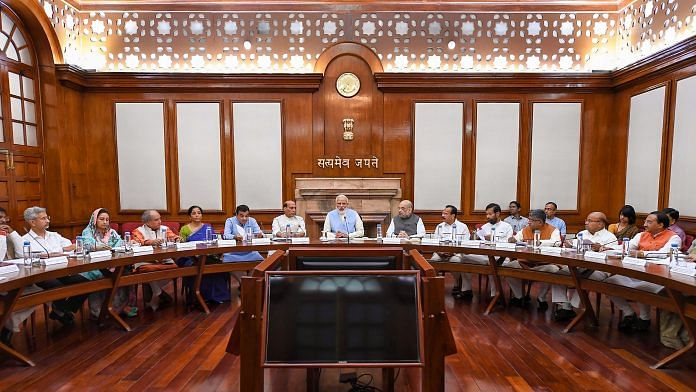New Delhi: As it reconstituted six cabinet committees and added two new ones Thursday, the Modi government more or less repeated its 2014 formula of keeping fewer panels, in line with Prime Minister Narendra Modi’s stated ‘minimum government maximum governance’ philosophy.
With the government making these changes, ThePrint takes a look at the role of the cabinet committees and what these new measures mean.
What is a cabinet committee?
The role of a cabinet committee — which comprises cabinet ministers and ministers of state — is to deliberate and take a final call on important policy issues related to different sectors such as security, politics, economy, among others.
Their primary aim is to reduce the workload of the cabinet and expedite the decision-making process.
The cabinet committees can be set up either directly by the prime minister or vetted by the cabinet. The PM heads a majority of the committees.
In the newly-reconstituted cabinet committees, PM Modi heads all the six panels, except parliamentary affairs and accommodation which will be chaired by Home Minister Amit Shah, according to tradition.
The committees are generally constituted for the entire term of the government but can be reconstituted if the PM wants. The prime minister may also add or reduce the number of such committees.
General housekeeping issues, related to appointments and accommodation, of ministers or even former presidents, are also dealt with by cabinet committees set up for the purpose.
Traditionally, while the PM heads the appointment committees, the home minister heads the committee on accommodation, which determines the rules to govern out-of-turn allotment of government accommodation.
The terms of the cabinet committees are defined in Government of India’s Transaction of Business Rules, 1961.
Apart from deliberating on key decisions, these committees also help the government in keeping senior leaders as well as allies in good humour by giving them key responsibilities. If the PM wants, he can include MPs who are not in the cabinet under the special invitee list.
Also read: Here’s the full list of Cabinet committees after reshuffle: PM heads 6, Amit Shah 2
Is there a limit to number of cabinet committees?
There is no fixed limit on the number of such panels that can be constituted. The government of the day is free to set up as many cabinet committees as the prime minister wishes to.
During the stint of India’s first prime minister Jawaharlal Nehru, there were just two cabinet committees — political and economic affairs. Subsequently, three more were added to the list — security, appointments and accommodation.
The number of such committees increased during the Indira Gandhi era.
Under P.V. Narasimha Rao’s tenure as prime minister, there were 13 cabinet committees.
The Manmohan Singh government, which was in power for 10 years between 2004 and 2014, had 12 cabinet committees.
However, after PM Modi took over in 2014, he retained just six of the key cabinet committees — on security, economy, political affairs, parliamentary affairs, appointments and accommodation.
On Wednesday, however, he added two new committees — investment & growth, and employment and skill development.
The committee on investment is not new, though. In 2013, too, the Manmohan Singh government had set up the cabinet committee on investment to expedite project implementation.
How many members do the cabinet committees comprise?
The number of members in the cabinet committee can vary from anything between two to 12. The panels on economic and parliamentary affairs are generally larger.
According to the newly-reconstituted committees, the present cabinet committees on political affairs and economic affairs have 12 members each.
Past instances of key cabinet committee decisions
Under the first Modi government, as with previous regimes, many key decisions were taken by the cabinet committees.
For instance, the cabinet committee on security (CCS) gave the go-ahead for the Rs-58,000 crore Rafale aircraft deal. Earlier, the cabinet committee on economic affairs (CCEA) in 2014 cleared the minimum support price hike for kharif crops for the 2014-15 season.
Such committees have deliberated on important security issues in the past too.
In the build-up to the Kargil conflict in 1999, a joint meeting of the CCS and the cabinet committee on political affairs was called to discuss the India-Pakistan relations.
Also read: Amit Shah emerges as de facto deputy PM after Cabinet committee reshuffle




Your article is too general whereas it is an important subject that is treated. Why not have accompanied your article with an overview of the ministerial committees set up since 1947. Such a presentation would have been useful for your readers. It would also make possible to understand the evolutions of the political system put in place, and in particular when the PM has a strong majority.This raises the question of the effectiveness of these committees,.
Under Modi these all cabinet committees are just Yes Man clubs
One remembers UPA’s GoMs, some empowered, others not so. Pranabda headed so many of them, often wondered how he found time to clear his own files.